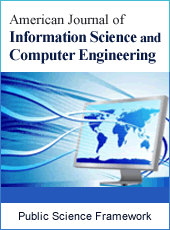American Journal of Information Science and Computer Engineering
Articles Information
American Journal of Information Science and Computer Engineering, Vol.1, No.2, Jul. 2015, Pub. Date: Jun. 17, 2015
Using Fuzzy ARTMAP for Symmetric Key Generation
Pages: 76-83 Views: 3293 Downloads: 1337
[01]
John Mulopa, National University of Science and Technology, Computer Science Department, Bulawayo, Zimbabwe.
[02]
Siqabukile Ndlovu, National University of Science and Technology, Computer Science Department, Bulawayo, Zimbabwe.
[03]
Kernan Mzelikahle, National University of Science and Technology, Computer Science Department, Bulawayo, Zimbabwe.
[04]
Thambo Nyathi, National University of Science and Technology, Computer Science Department, Bulawayo, Zimbabwe.
Neural cryptography deals with the problem of key exchange between two communicating neural networks using the mutual learning concept. It is the first algorithm for key generation over public channels which are not based on the number theory. The two networks exchange their outputs and the key between the two communicating parties is eventually presented in the final learned weights, when the two networks are synchronised. The security of neural synchronisation is put at risk if an attacker is capable of synchronising with any of the two parties during the training processes. However, the security of a cryptosystem is robust if the algorithm is strong and the keys are long, unpredictable, and random This research proposes use of two distant remote Adaptive Resonance Theory MAP (ARTMAP) architectures that are trained to learn from a unique data set and finally synchronise to same weights.
Neural Networks, Cryptography, Cryptosystem, Synchronisation, Key Generation, Artmap
[01]
Modaressi, A. R., S. Mohan, 2000. Control and management in Next-Generation Networks: challenges and opportunities. IEEE Commun. Mag., 38:94-102.
[02]
Oates J.B., (2011). Researching Information Systems and Computing.Sage Publications Inc, California, USA.
[03]
Pratap S., Harvir S. Cryptography in structure adaptable digital neural networks. National monthly referred journal of research in science and technology. Vol 1, issue 12: ISSN 2277-1174.
[04]
Stallings W., (2010) Cryptography and Network Security: Principles and Practice, (5th Edition), Prentice Hall, 2010.
[05]
Kelsey J., B. Schneier, D. Wagner, C. Hall: Cryptanalytic Attacks on Pseudorandom Number Generators.
[06]
Santhanalakashmi S, K. Sangeeta, G.K. Patra (2012). Design of stream Cipher for Text Encryption using Soft Computing based Techniques. International Journal of Computer Science and Network Security, Vol.12 No. 12.
[07]
Carpenter, G.A, M.N Gjaja, S. Gopal, N Markuzon, C.E. Woodcock. (1996). ART and ARTMAP Neural Networks for Applications: Self-Organizing learning, Recognition, and Prediction. Boston University, Technical Report CAS/CNS TR-96-009. Massachusetts 02215 USA.
[08]
Carpenter, G.A., Grossberg, S., and Reynolds, J.H. (1991a). ARTMAP: Supervised real-time learning and classification of nonstationary data by a self-organizing neural network. Neural Networks, 4, 565-588.
[09]
Carpenter, G.A. and Grossberg, S. (1992). Fuzzy ARTMAP: Supervised learning, recognition, and prediction by a self-organizing neural network. IEEE Communications Magazine, 30, 38-49.
[10]
Carpenter, G.A., Grossberg, S., Markuzon, M., Reynolds, J.H., and Rosen, D.B. (1992). Fuzzy ARTMAP: A neural network architecture for incremental supervised learning of analog multidimensional maps. IEEE Transactions on Neural Network, 3,698-713.
[11]
Carpenter, G.A., Grossberg, S., and Rosen, D.B. (1991b). Fuzzy ART: Fast stable learning and categorization of analog patterns by an adaptive resonance system. Neural Networks, 4, pp. 759-771.
[12]
Shukla N., A. Tiwari. An Empirical Investigation of Using ANN Based N-State Sequential Machine and Chaotic Neural Network in the Field of Cryptography‖, Global Journal of Computer Science and Technology Neural & Artificial Intelligence, Vol. 12, Issue.10,No. 1,17-26, 2012.
[13]
Prabakaran N., P. Loganathan, P. Vivekanandan, 2008. Neural cryptography with multiple transfers functions and multiple learning rule. International Journal of soft computing 3 (3):177-181.
[14]
Kanter I., Kinzel W, Kanter E. Secure Exchange of information by synchronisation of neural networks, Europhys, Lett. 57, 141, 2002.
[15]
Revankar P, W.Z. Gandhare, D Rathod. Private Inputs to Tree Parity Machine. International Journal of Computer Theory and Engineering, Vol. 2, No. 4, August, 2010: 1793-8201.
[16]
Geetha B, E. Vani, V. Prasad. A Hybrid Model for Secure Data Transfer in Audio Signals using HCNN and DD DWT‖, (IJACSA) International Journal of Advanced Computer Science and Applications, Vol. 4, No.7, 202-208, 2013.
[17]
Ruttor A., G. Reents, W. Kinzel, 2004. Synchronisation of random walk with reflecting boundaries. J. Phys. A: Math.Gen, 37:8609 [condmat/0405369].
[18]
Vaishnvai V., W. Kuechler (2004). Design Science Research in Information Systems, January 20,2004; last updated: October 2013. Available: http://www.desrist.org/design-research-in-information-systems/ (Accessed 20 February 2015)
[19]
Hevner, A. (2007). A three-cycle view of design science research, Scandinavian Journal of Information Systems 19 (2), pp. 87–92
[20]
Bedford D.F, G. Morgan, and J. Austin, “A Draft Standard for the Certification of Neural Networks in Safety Critical Systems,” Artificial Neural Networks in Engineering, November 1996
[21]
Taylor B.J.,(2006). Methods and Procedures for the Verification and Validation of Artificial Neural Networks. Springer, Fairmont, USA.

ISSN Print: 2381-7488
ISSN Online: 2381-7496
Current Issue:
Vol. 7, Issue 3, September Submit a Manuscript Join Editorial Board Join Reviewer Team
ISSN Online: 2381-7496
Current Issue:
Vol. 7, Issue 3, September Submit a Manuscript Join Editorial Board Join Reviewer Team
| About This Journal |
| All Issues |
| Open Access |
| Indexing |
| Payment Information |
| Author Guidelines |
| Review Process |
| Publication Ethics |
| Editorial Board |
| Peer Reviewers |


